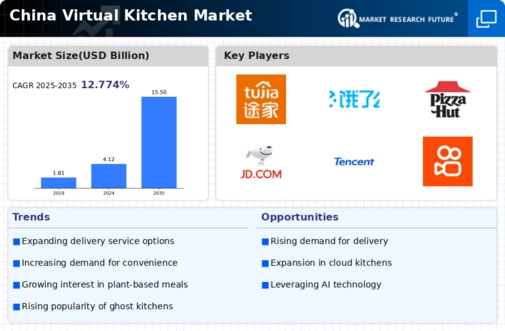Rising Disposable Incomes
Increasing disposable incomes among Chinese consumers significantly influence the virtual kitchen market. As economic conditions improve, individuals are willing to spend more on dining experiences, including food delivery services. Data shows that the average disposable income in urban areas has risen by approximately 8% annually, leading to greater expenditure on convenience foods. This trend indicates that the virtual kitchen market could see a substantial uptick in demand as consumers prioritize quality and convenience in their food choices, reflecting a shift in consumer behavior towards more premium offerings.
Health and Wellness Trends
The growing emphasis on health and wellness among Chinese consumers is shaping the virtual kitchen market. As awareness of nutrition and healthy eating increases, there is a rising demand for meal options that cater to health-conscious individuals. Virtual kitchens that offer balanced, nutritious meals are likely to attract a significant customer base. Market analysis suggests that health-oriented food services could capture up to 25% of the total food delivery market by 2026. This shift towards healthier eating habits presents an opportunity for virtual kitchens to innovate and provide tailored meal solutions that align with consumer preferences.
Urbanization and Changing Lifestyles
The rapid urbanization in China is reshaping the food consumption landscape. This change significantly impacts the virtual kitchen market. As more individuals migrate to urban areas, the demand for convenient meal solutions rises. Urban dwellers often lead busy lives, which drives the need for efficient food delivery services. According to recent data, urban populations in China are projected to reach 70% by 2030, indicating a substantial market for virtual kitchens. This demographic shift suggests that the virtual kitchen market will likely thrive as it caters to the fast-paced lifestyles of city residents, providing them with quick and accessible meal options.
E-commerce Growth and Digital Adoption
The surge in e-commerce and digital platforms in China is a pivotal driver for the virtual kitchen market. With the increasing penetration of smartphones and internet access, consumers are more inclined to order food online. Reports indicate that online food delivery services have seen a growth rate of over 30% annually in recent years. This trend suggests that the virtual kitchen market is well-positioned to capitalize on the growing preference for online ordering, as consumers seek convenience and variety in their meal choices. The integration of technology in food services enhances customer experience, further propelling market growth.
Government Support and Regulatory Framework
The Chinese government is increasingly supportive of the food delivery sector, which positively impacts the virtual kitchen market. Initiatives aimed at promoting entrepreneurship and innovation in the food industry are likely to foster growth. Regulatory frameworks that facilitate food safety and quality assurance are essential for building consumer trust. Recent policies have encouraged the establishment of cloud kitchens, which are integral to the virtual kitchen market. This supportive environment may lead to increased investment and expansion opportunities, allowing businesses to thrive in a competitive landscape.






















Leave a Comment